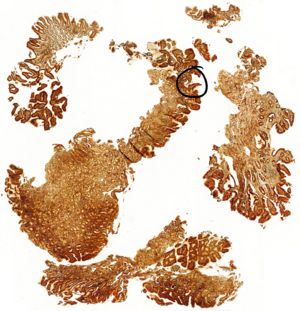2. Helicobacter pylori infection (Warthin-Starry): Difference between revisions
(Created page with "'''Staining''': Warthin-Starry stain '''Organ''': Gastric antrum '''Description''': Along the mucosa can we see small black dots, which are stained H. pylori bacteria. '''Diagnosis''': Helicobacter pylori infection '''Causes''': * Helicobacter pylori infection '''Theory''': This sample is taken by biopsy, which explains why the tissue sample is fragmented. The sample is taken from the pyloric antrum. H. pylori is famous for causing peptic ulcers in the stomach,...") |
No edit summary |
||
| (One intermediate revision by the same user not shown) | |||
| Line 1: | Line 1: | ||
'''Staining''': Warthin-Starry stain | [[File:H. pylori infection - overview.png|thumb|The ring shows a site where you can find lots of bacteria, but you can find them anywhere on the slide.]]'''Staining''': Warthin-Starry stain | ||
'''Organ''': Gastric antrum | '''Organ''': Gastric antrum | ||
| Line 15: | Line 15: | ||
'''Theory''': | '''Theory''': | ||
This sample is taken by biopsy, which explains why the tissue sample is fragmented. The sample is taken from the pyloric antrum. | This sample is taken by biopsy, which explains why the tissue sample is fragmented. The sample is taken from the pyloric antrum.[[File:H. pylori infection - bacteria.png|thumb|The small black dots are bacteria|372x372px]]H. pylori is famous for causing peptic ulcers in the stomach, however 85% of people with the bacterium in their stomach are asymptomatic. In addition to peptic ulcer disease can the bacterium also cause gastritis, adenocarcinoma and <abbr>MALT</abbr> lymphoma in the stomach. | ||
H. pylori is famous for causing peptic ulcers in the stomach, however 85% of people with the bacterium in their stomach are asymptomatic. In addition to peptic ulcer disease can the bacterium also cause gastritis, adenocarcinoma and <abbr>MALT</abbr> lymphoma in the stomach. | |||
[[Category:Pathology 2 - Histopathology slides]] | [[Category:Pathology 2 - Histopathology slides]] | ||
Latest revision as of 13:11, 7 July 2024

Staining: Warthin-Starry stain
Organ: Gastric antrum
Description:
Along the mucosa can we see small black dots, which are stained H. pylori bacteria.
Diagnosis: Helicobacter pylori infection
Causes:
- Helicobacter pylori infection
Theory:
This sample is taken by biopsy, which explains why the tissue sample is fragmented. The sample is taken from the pyloric antrum.

H. pylori is famous for causing peptic ulcers in the stomach, however 85% of people with the bacterium in their stomach are asymptomatic. In addition to peptic ulcer disease can the bacterium also cause gastritis, adenocarcinoma and MALT lymphoma in the stomach.
